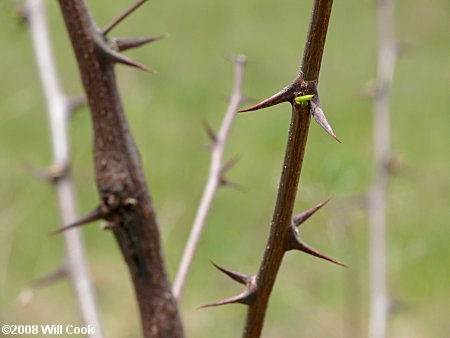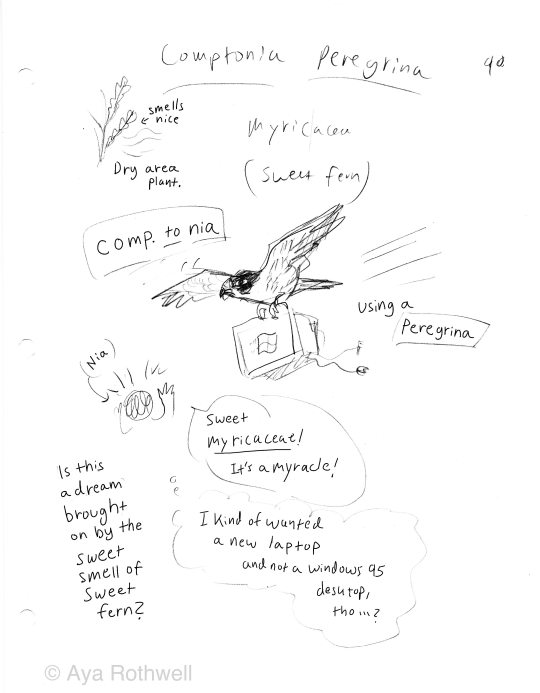I memorized lots of plants for a field botany class. Here are some notes.
Don't wanna be here? Send us removal request.
Text
Robinia pseudoacacia (Black locust), Fabaceae
Robinia pseudoacacia (Black locust)
Family: Fabaceae

(Photo by Frank Bramley, from GoBotany)

http://www.carolinanature.com/trees/rops.html
Thorns!
From GoBotany: “Black locust is native to parts of North America, but has greatly increased its range, being widely planted as a hardy street three and for erosion control. It has an upright, narrow crown, widest at the top, producing masses of white, fragrant pea-like flowers that mature into flat pods in the fall. The ropy brown bark and red spines that line the new shoots also distinguish this locust from its relatives. Black locust thrives on nutrient-poor sites because it teams up with a bacterium that fixes nitrogen from the soil. Because it suckers readily and spreads widely, it has become invasive in certain portions of its range.”
So this is what an actual acacia tree looks like:

https://thenaturalhistorian.com/2017/01/23/on-the-origin-of-thorns-the-prelapsarian-acacia-and-the-good-creation/
“Pseudoacacia” is a pretty good name.
“Fabaceae” is the family of peas. It blew my mind that everything from little sensitive peas (Chamaecrista fasciculata) to clovers (Trifolium) to these great big thorny Black locusts are in the same family. But they do all have that pea flower, in some form or another. “The fabulous fabaceae” is an easy mnemonic.
Anyway, so here’s the comic I drew for myself in order to memorize the full name (Robinia pseudoacacia, Black locust, family Fabaceae).

1 note
·
View note
Text
Comptonia peregrina (Sweet fern), Myricaceae
Comptonia peregrina (Sweet fern)
Family: Myricaceae
Note: this is not a fern! It sort of looks like one, but it’s not! And that’s why common names are sometimes not helpful.

(Photo by Arthur Haines, from GoBotany)
From GoBotany: “One sniff of the pungent, turpentine-like aroma given off by the crushed leaves of this 3-foot (1m) tall shrub, and its common name, sweet-fern, will become clear. Sweetfern fixes nitrogen through a close partnership with bacteria; thus, this plant is among the first to colonize barren, nutrient-poor soils.”
This is a dry area plant. I’ve seen this as an ornamental plant in public spaces, too. If you find a sweet fern, crush a leaf and smell it, it’s really nice!
Anyway, here’s my doodle for learning the plant name.

0 notes
Text
Rubus hispidus and Rubus flagellaris, Rosaceae
Rubus hispidus (Bristly dewberry, swamp dewberry, bristly blackberry)
Family: Rosaceae

(Hipsidus photo by Marilee Lovit, from GoBotany.

(Hispidus photo by Merel Black, from GoBotany.
From GoBotany: “Bristly blackberry is a common trailing species partial to wet habitats. Its arching stems bear three-parted compound leaves and are armed with numerous bristles that are narrow at the base. The stems can root at the tips, producing new stems. The fruits of bristly blackberry are eaten by many species of birds.”
So there’s a somewhat similar-looking creeping plant called Rubus flagellaris (Northern dewberry).

(Flagellaris photo by Glen Mittelhauser, from GoBotany.)
Here’s some tips from one of my botany instructors, Robin, on telling the difference between the two plants:
*Rubus hispidus has shiny leaves, flagellaris doesn’t.
*Flagellaris has recurved thorns and will rip up your leg if you try and walk through it. That plant is out to get you. (The last sentence is from me.) Actually, young flagellaris can look/feel a little like hispidus, with delicate softish thorns. But generally, if you try and grab the stem of a flagellaris, it’s not pleasant.
I don’t even need to post a full mnemonic for Rubus flagellaris. Flagillating flagellaris. Done.
Anyway, here’s a doodle I drew to remember Rubus hispidus.

Other mnemonic notes
“Rubus” and “Rosaceae” mnemonics -- at this point in the class, we had learned a few Rubus blackberry-ish plants already and people were tossing around the name “Rubus” and “Rosaceae” like it was normal English lingo, so I just learned the names from that. But, here....
If you Rub us Rubus on the stem, you’ll find we have thorns, because we are in the thorny Rosaceae family.
Well, except Bristly dewberry, which is most bristly and not really thorny. But the flower is still that distinct small white flower that pops up in a lot of Rosaceaes.
#Rubus hispidus#Rubus flagellaris#Rosaceae#Northern Dewberry#Bristly dewberry#botany#mnemonics#cartoons#Pie
0 notes
Text
Berberis thunbergii (Japanese barberry), Berberidaceae
Berberis thunbergii (Japanese barberry)
Family Berberidaceae

(Photo by Donna Kausen from GoBotany)
From GoBotany: "Japanese barberry is a thorny shrub, introduced for hedgerow and other plantings in 1875. By 1910 it was recognized as a frequent garden escapee. Now this invasive species is widespread and can persist in forest understories long after a homestead is abandoned. It has been shown to alter forest soil cycling through its association with invasive earthworms. Birds, particularly wild turkeys and grouse, relish the chalky berries and spread the seeds of Japanese barberry far and wide. With its spines and dense growth pattern, it provides a formidable natural barrier or fence.”
Pretty bad invasive! Japanese Barberry even brings in invasive earthworms, talk about a cascade effect of invasive species. Japanese Barberry also increases tick numbers and helps to spread Lyme disease!
Identifying: This plant has those distinct small leaves. Also, on top of being invasive, it has thorns! Which hurt! And you can still find people/places selling and planting this invasive plant as an ornamental shrub. So it’s fairly easy to find, unfortunately.
“thunbergii” -- later in the course, one of the instructors (Noah) told us about Thunberg, a famous person in the plant world, and how people have named plants after him (AKA why a number of plants are called “thunbergii”).
I didn’t know that when I was setting up a mnemonic for this plant. Anyway, going with how scary this plant is, here’s the doodle I drew.

1 note
·
View note
Text
Osmunda regalis (Royal fern), Osmundaceae
Osmunda regalis (Royal fern)
Family: Osmundaceae

(Photo By Glen Mittelhauser from GoBotany)
From GoBotany: “Royal fern is a cosmopolitan species, and may be the only vascular plant found on all seven continents. It is common throughout New England in swamps, shorelines and riparian forests. The ferile* pinnae of royal fern rise above the sterile pinnae, looking somewhat like a crown, hence the name.”
(*ferile? They probably meant fertile?)
This is a pretty distinct-looking fern. I, for one, would wear it taped to my head and walk around being regal. Or make a crest or herald of it. Anyway, so here’s a character named Osmunda / Osmund who is being regal.
Family name is Osmundaceae, that’s pretty straightforward.

0 notes
Text
Smilax glauca (Cat greenbrier), Smilacaceae
Smilax glauca (Cat greenbrier, glaucous-leaved greenbriar)
Family: Smilacaceae

(Photo by Arthur Haines from GoBotany.)
From GoBotany: “Glaucus-leaved greenbriar is a climbing, prickly vine with bluntly triangular leaves that have three prominent, parallel veins and a white (glaucous) bloom on the undersides. Birds eat the berries, particularly in winter.”
“Smilax” -- So I already knew “Smilax” because I had a field crew leader who would get tangled in greenbriar and yell at the plant, “Smilax, stop smilax-ing!” This happened enough times that I remembered the general plant name “smilax”.
"Glauca” -- Almost the same “glaucus”, or when plants have a pale whitish or greenish-whitish color. Sort of waxy, can rub off. AKA the color of the underside of cat greenbrier leaves, as mentioned. AKA Glaucus, Greek sea-god, apparently (on googling it).
Just to drive home the point, I doodled a glaucous-colored cat with dark-green cat greenbrier ears.

0 notes